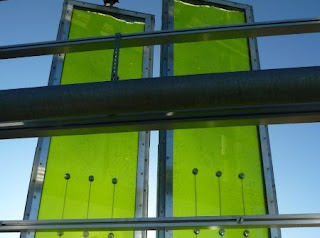We are all familiar with eco-friendly options for green roofs and walls. The advantages of a green roof are that it adds thermal mass to the building envelope, assists with managing the dispersal of rain water and allows a degree of photosynthesis from the plant life. Planting options are increasing all the time to maximise biodiversity. Unfortunately it's not appropriate for every project.
 |
| Green roof system |
More recently the technology for hydroponic walls have been developed and quite a few companies produce them now. There was a bit of a jungle corner at Ecobuild this year.
 |
| Patrick Blanc vertical garden |
But GXN are playing with a number of cleaver new materials and building systems which can advance the construction industry still further as an environmentally sensitive concern:
Phase change materials (PCMs):
PCMs have been around for a while and phase change plasterboard has had publicity in the UK. Now there are a number of alternatives to consider. The advantages of PCMs are that they trap heat as the environment within a building warms up, and release it as the building cools down. This assists to stabilise the building's environment within comfort zones, reduce the amount of heat lost to the outside through the building envelope, and reduce energy loads on air conditioning systems. Currently most of the products are paraffin based as this material can change state from liquid to solid at around 18 deg C. To illustrate the potential significance of these products, the amount of energy required to transform a beaker of water to ice at 0 deg C is the same as the energy required to heat the water from 0 to 80 deg C.
Micronal Smart Board is probably the best known and comes in plasterboard sheets.
 |
| BASF Micronal Smart Board |
DuPont produces Energain, heat responsive thermal mass panels.
 |
| DuPont Energain |
Rubitherm is another parafin based PCM.
 |
| Rubitherm material |
Lehmorange are clay panels with paraffin based PCM additives. The clay also helps to regulate moisture levels.
 |
| Lemorange |
Air purifying materials
These materials include chemicals such as titanium dioxide which works with UV radiation to produce an air-purifying affect called photocatalysis. This breaks down dirt and organic nasties and traps some pollutants such as nitric oxide, which are then washed away with rain. Pilkington have been marketing Activ glass for some time which has a titanium dioxide film to the outer face, but now there are more products to consider:
Hydrotect is a tile product. The manufacturers claim 100m2 cleans the air as effectively as 7 (medium sized) deciduous trees.
 |
| The hydrotect affect... |
Tensotherm is a PTFE tensile membrane with a titanium dioxide coating. The PTFE envelopes can be filled with Nanogel for a highly insulating product.
 |
| Shopping under Tensotherm |
ClimaLife are a concrete roof tile coated with titanium dioxide to stay clean and free from mould etc..
 |
| ClimaLife roof tiles - available in several colours... |
Noxite comes as a roofing felt or single tile coated with titanium dioxide to remain clean throughout its design life.
 |
| Noxite roofing shingles |
Algae facade systems
Arup Materials Consulting team have been working on an exciting facade system which contains an algae solution in the cavities of glazing units. The algae's growth during the day can be calibrated to work with the shading requirements of the building. Heat generated can be captured and used within the building and the biomass from the algae can be harvested and used for heat and power: A living, breathing high-tec facade system.
 |
| Algae facade system |
